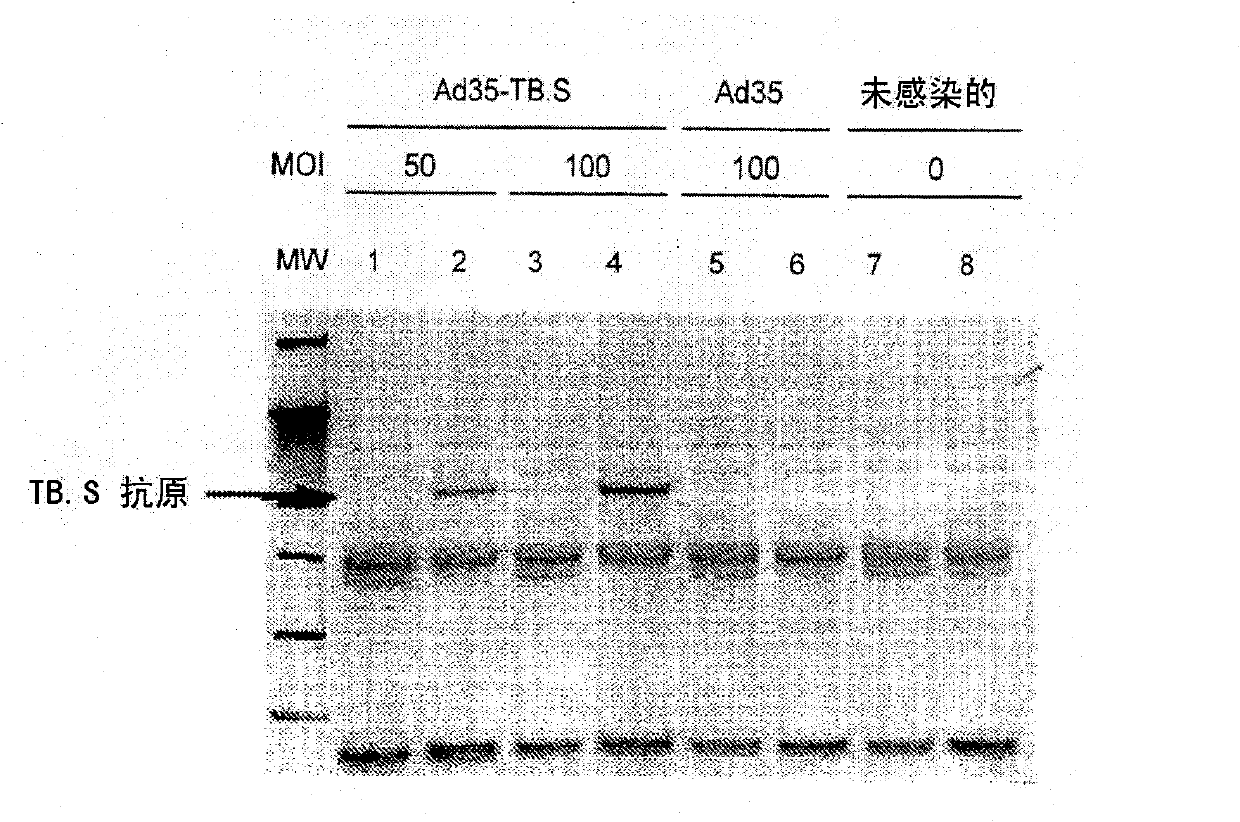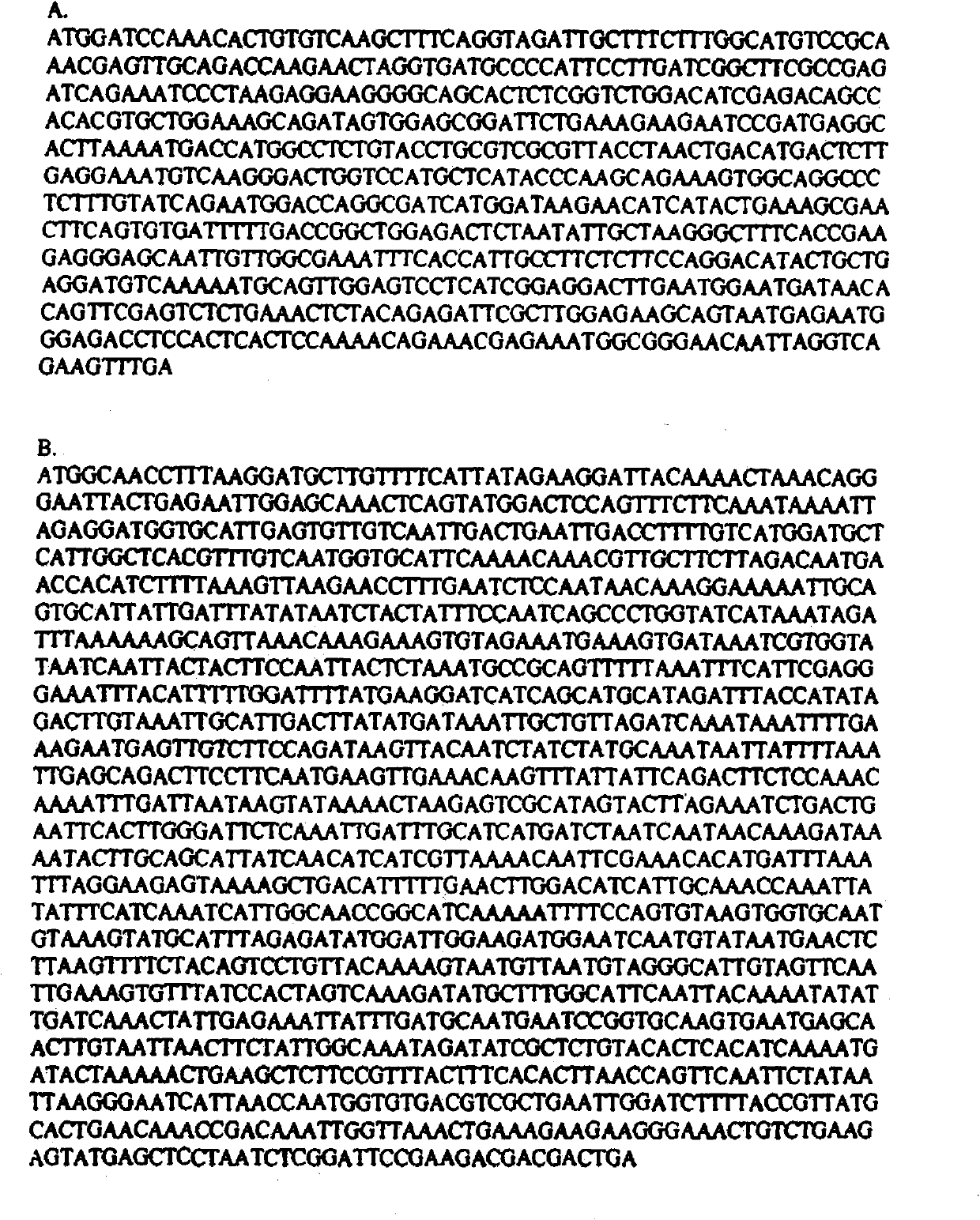Enhancement of transgene expression from viral-based vaccine vecors by expression of suppressors of the type i interferon response
A recombinant viral vector, interferon technology, applied in the direction of virus/phage, antisense single-stranded RNA virus, virus, etc., can solve the problem of inability to distinguish viral infectious agents, failure of the purpose of vaccine administration, and attenuation of vaccine vector capacity.
- Summary
- Abstract
- Description
- Claims
- Application Information
AI Technical Summary
Problems solved by technology
Method used
Image
Examples
Embodiment 1
[0034] Example 1. IFN antagonist gene VAI increases the expression of TB.S antigen
[0035] This experiment describes the use of an interferon antagonist gene to reduce the negative effect of IFNs on expression of cloned tuberculosis antigens in adenoviral vectors. Experiments were designed and performed as described below.
[0036] Ad35-TB.S is a replication-defective, El-deleted derivative of adenovirus 35 encoding a fusion protein of antigens 85A, 85B and TB10.4 from Mycobacterium tuberculosis. Like other group B adenoviruses, adenovirus 35 infects mammalian cells expressing the surface marker CD46, and is thus capable of infecting the vast majority of all nucleated human cells. The interferon antagonist gene used in this experiment was the virus-associated I (VAI) RNA gene. The VAI RNA gene product resists the antiviral response of cells by blocking the activation of interferon-induced double-stranded RNA-activated protein kinase PKR (Galabru J, Katze MG, Robert N, Hovan...
Embodiment 2
[0040] Example 2. IFN antagonist gene NS1 increases the expression of hemagglutinin (HA) protein
[0041] Adenoviral vector vaccine constructs were prepared encoding the IFN I inhibitory protein NS1 from influenza virus and the hemagglutinin (HA) protein from avian influenza H5N1 in a bicistronic expression cassette. Expression of the HA transgene in cells infected with this adenovirus vaccine construct was compared to expression in A549 and Hela cells infected with a similar adenovirus vaccine construct expressing the same HA transgene but not NS1 protein. Higher levels of HA were expressed in cells that also expressed NS1. This study validates the approach of using adenoviral vectors encoding and expressing inhibitors of type I interferons in addition to encoding and expressing the transgene of interest.
Embodiment 3
[0042] Example 3. Enhancement of Immunogenicity of Vaccines by Inclusion of Type I IFN Response Inhibitors
[0043] To demonstrate the effect of suppression of type I IFN responses on immune responses elicited by viral vectors, 3 groups of 10BALB / c mice were vaccinated as follows. The first group received saline only, 100 μL intramuscular injection; the second group received an adenovirus serotype 35 vector encoding a fusion protein of Mycobacterium tuberculosis antigens 85A, 85B and RV3407, 10 10 pfu intramuscularly; the third group received an adenovirus serotype 35 vector encoding a fusion protein of Mycobacterium tuberculosis antigens 85A, 85B and RV3407 and the VAI gene, 10 10 Intramuscular injection of pfu. All animals were post-priming with the same vaccine for 2 weeks. All animals undergoing a two week post boost were euthanized and spleens and blood collected.
[0044]Immunization and other methods of measuring biological responses to encoded products in animal mod...
PUM
 Login to View More
Login to View More Abstract
Description
Claims
Application Information
 Login to View More
Login to View More - R&D
- Intellectual Property
- Life Sciences
- Materials
- Tech Scout
- Unparalleled Data Quality
- Higher Quality Content
- 60% Fewer Hallucinations
Browse by: Latest US Patents, China's latest patents, Technical Efficacy Thesaurus, Application Domain, Technology Topic, Popular Technical Reports.
© 2025 PatSnap. All rights reserved.Legal|Privacy policy|Modern Slavery Act Transparency Statement|Sitemap|About US| Contact US: help@patsnap.com



